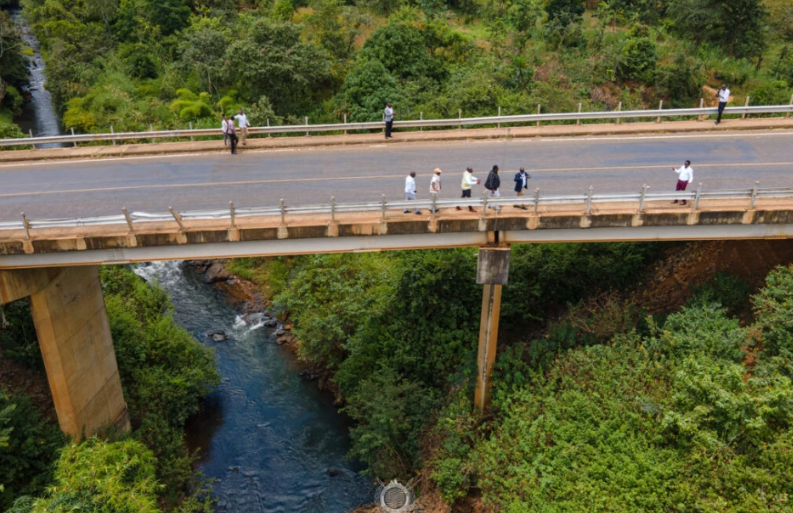The Nithi Bridge in Tharaka Nithi County has earned a grim reputation as a “killer bridge.” Situated on the Embu-Meru road in eastern Kenya, it is notorious for its long history of severe and fatal accidents, making it one of the most dangerous blackspots in Kenya.
On August 31, twelve people lost their lives at the bridge when a van collided head-on with a pick-up truck transporting Miraa to Nairobi. Police reports indicate that all occupants of the van were killed, while those in the other vehicle sustained serious injuries.
Constructed in the early 1980s, the Nithi Bridge has long been a site of tragedy. Its design features steep declines, sharp curves, and inadequate safety measures, which contribute to the frequent accidents that plague it. The treacherous approach to the bridge highlights why it is associated with such high levels of road carnage, making it an unappealing route for those wary of danger.
A Dark History of the Nithi Bridge
Over the years, the Nithi Bridge has been the scene of numerous fatal accidents. One of the most tragic occurred in 2000 when a bus plunged into the river below, resulting in over 45 deaths. The bridge has consistently been in the news due to frequent fatalities and injuries.
In April 2018, a bus overturned near the bridge due to brake failure, leading to 2 deaths and more than 20 injuries. In January 2019, a head-on collision between a lorry and a 14-seat public van resulted in 4 deaths and 11 injuries.
February 2021 saw another tragedy when a 14-seat public van collided with a truck, killing 5 people on the spot and leaving others injured. In July 2022, a bus carrying 45 passengers fell off the guard rails, claiming 33 lives, while the survivors suffered severe injuries.
Most recently, in April 2024, a Nairobi-bound bus rolled at the notorious Nithi Bridge, killing 4 people and seriously injuring over 8. The most recent incident, on August 31, 2024, involved a head-on collision between a 14-seat public van and a Miraa pick-up, resulting in 12 deaths and several injuries.
Despite the increasing number of accidents and fatalities, the Nithi Bridge remains a dangerous blackspot, urgently needing intervention. Leaders from Meru have repeatedly called for a redesign to reduce the frequency of these incidents.
On Sunday, former Agriculture Cabinet Secretary Mithika Linturi urged for the bridge’s swift redesign and reconstruction during an event attended by Deputy President Rigathi Gachagua. Gachagua indicated that he had contacted President William Ruto, who assured him that the redesign plans for the Nithi Bridge are nearly complete and will be available soon. He pledged to oversee the implementation of these changes, honoring a commitment made to the Meru people.
EMPTY PROMISES: A HISTORY OF UNFULFILLED COMMITMENTS
Since the Nyayo era, promises to redesign the bridge have been made, often in response to the severe accidents that have occurred. However, these promises have largely remained unfulfilled. Both President Mwai Kibaki and President Uhuru Kenyatta’s administrations did not address the issue.
President Ruto’s Kenya Kwanza government is now under scrutiny for its commitment to redesign the bridge.
During the 2022 presidential campaign, President William Ruto promised to redesign the Nithi Bridge within 180 days (six months) of taking office. Nearly two years into his presidency, this promise remains unfulfilled, continuing to result in loss of life and property. The new assurance from Gachagua that road engineers are nearing the completion of the redesign will be closely watched.
Immediate action is needed to address the safety and design issues affecting this road. Without such interventions, the Nithi Bridge will persist as a symbol of road carnage, causing further fatalities and injuries while undermining Kenya’s road safety efforts.
FAULTY DESIGN AND INADEQUATE SAFETY MEASURES
Experts attribute the high fatality rates on the Nithi Bridge to its design, particularly its location on a steep 3-kilometer decline coming from Meru County. The bridge’s design and lack of sufficient safety measures contribute significantly to the dangerous conditions that lead to frequent accidents.
With its dizzying twists, meandering descent, and uneven bumps, the Nithi Bridge poses a hazard even to the most cautious drivers. For those unfamiliar with the road, it is best navigated in daylight, where visibility enhances decision-making and judgment.
The Nithi Bridge, spanning approximately fifty meters, is notably narrow. This design flaw, combined with human error, has contributed to numerous fatalities over the years, with successive governments failing to implement necessary corrective measures.
Constructed in 1983, the bridge is now over 40 years old, making it overdue for a redesign and reconstruction to enhance public safety.
WHAT A REDESIGN SHOULD INCLUDE
The lack of adequate warning signs, insufficient or missing guardrails on the shoulders, and poor or absent road markings all contribute to the danger associated with the bridge. Improving the 40-meter drop into the bridge area would help heavy vehicle drivers maintain better control of their trucks and buses. These issues should be prioritized by the responsible government agency.
A redesign of the bridge could involve relocating the road and incorporating modern civil engineering techniques to ensure a manageable gradient over the river. It might also include widening the road to accommodate larger vehicles safely. The redesign should be executed meticulously to ensure durability and safety for future generations.
As the bridge is redesigned and reconstructed, it is crucial that funding is not cited as an excuse for delay, and that the quality of the work is not compromised by corruption. Public roads and bridges are essential community assets, and the government has a duty to ensure their maintenance and safety are upheld with the highest standards.


